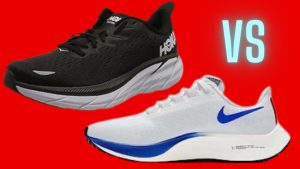Continue reading to discover more about the specific features that make each shoe unique, and gain insights into how they can enhance your running performance.
Digging Deeper: Other Key Factors And Features To Consider Before Your Final Decisions.
Pro tips Navigating the Decision: Making Your Choice
Now that you have a better understanding of how Hoka and Nike approach fittings, the next step is narrowing down your options to find the perfect pair for you. Here are some additional factors to consider when making your decision:
Your Running Style and Preferences
Terrain:
Are you primarily a road runner, or do you prefer hitting the trails? Consider the type of terrain you’ll be tackling most often, as this can influence the type of shoe that best suits your needs. Hoka offers a range of options tailored to different surfaces, including road, trail, and even track-specific models. Nike also provides specialized shoes for various terrains, so be sure to choose a shoe that’s optimized for your preferred running environment.
Distance:
Think about the distance of your typical runs. Are you training for a marathon or prefer shorter, faster-paced workouts? Hoka’s plush cushioning and Meta-Rocker technology make it an excellent choice for longer distances, providing the comfort and support needed to keep you going mile after mile. Nike offers a variety of options suited to different distances and paces, so consider how much cushioning and responsiveness you prefer for your runs.
Your Foot Type and Fit Preferences
Foot Shape:
Take into account the shape of your feet and any specific fit preferences you may have. If you have wide feet or prefer a roomier toe box, Hoka’s generous fit may be more accommodating. On the other hand, if you prefer a snug and secure fit that molds to your foot, Nike’s dynamic fit systems offer customizable options for a personalized feel.
Arch Support:
Consider your arch type and whether you require additional support or stability features in your shoes. Both Hoka and Nike offer models with varying levels of arch support to cater to different foot types, so be sure to choose a shoe that provides the right amount of support for your individual needs.
Try Before You Buy
In-Store Fitting:
If possible, visit a specialty running store to try on different models and get expert advice from trained staff. They can assess your gait, foot shape, and running style to recommend the best options for you. Trying on multiple pairs and testing them out with a short jog around the store can help you narrow down your choices and ensure a proper fit.
Online Resources:
If you’re unable to visit a store in person, many online retailers offer virtual fitting tools and sizing guides to help you find the right shoe from the comfort of your home. Be sure to carefully read reviews and reach out to customer service if you have any questions or concerns about sizing and fit.
Final Thoughts
Ultimately, the best way to determine which brand and model are right for you is to try them out and see how they feel on your feet. Whether you’re drawn to the plush comfort of Hoka or the precision fit of Nike, finding the perfect pair of running shoes is a personal journey that requires careful consideration of your unique needs and preferences.

Mike the founder of The Shoe String Forum.com, has always had a lifelong love for shoes since he was a kid and with a fervent love for diverse brands like Adidas, Puma, Louis Vuitton, Nike, Birkenstocks, Hey Dudes, Crocs, Vans, Uggs, Converse, and New Balance, he passionately shares extensive footwear research through this platform.

